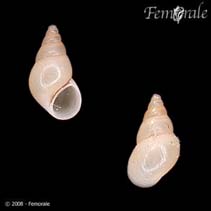Potamopyrgus antipodarum (Gray, 1853)
New Zealand mudsnail
Classification / Names Common names | Synonyms | CoL | ITIS | WoRMS
Gastropoda | Littorinimorpha | Hydrobiidae
Environment: milieu / climate zone / depth range / distribution range Ecology
Benthic; freshwater; brackish; depth range 4 - 45 m (Ref. 115293). Temperate
Distribution Countries | FAO areas | Ecosystems | Occurrences | Introductions
Southwest Pacific and Northeast Atlantic.
Length at first maturity / Size / Weight / Age
Maturity: Lm ? range ? - ? cm
This species is a surface detritivore (Ref. 95728). Deposit feeder, ingesting sediment particles (Ref. 115292). Abundant herbivores of freshwater littoral zones (Ref. 115285), feeding on microalgae. Omnivorous (Ref. 115284).
Life cycle and mating behavior Maturity | Reproduction | Spawning | Eggs | Fecundity | Larvae
Members of the order Neotaenioglossa are mostly gonochoric and broadcast spawners. Life cycle: Embryos develop into planktonic trocophore larvae and later into juvenile veligers before becoming fully grown adults.
Main reference
References | Coordinator | Collaborators
Healy, B. 1997. (Ref. 2779)
IUCN Red List Status (Ref. 130435)
Least Concern (LC) ; Date assessed: 22 July 2011
CITES status (Ref. 108899)
Not Evaluated
CMS (Ref. 116361)
Not Evaluated
Threat to humans
Human uses
| FishSource |
Tools
More information
Internet sources
BHL | BOLD Systems | CISTI | DiscoverLife | FAO(Publication : search) | Fishipedia | GenBank (genome, nucleotide) | GloBI | Gomexsi | Google Books | Google Scholar | Google | PubMed | Tree of Life | Wikipedia (Go, Search) | Zoological Record
Estimates based on models
Price category
(Ref. 80766):
Unknown.



